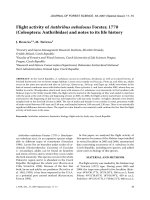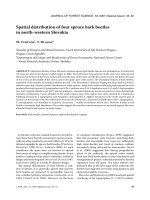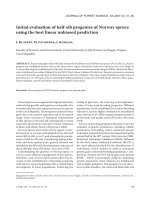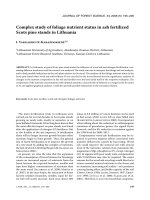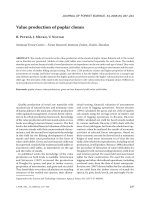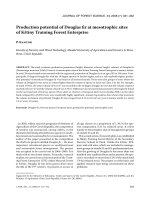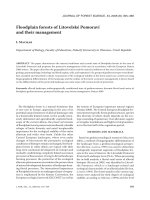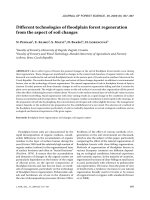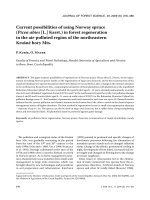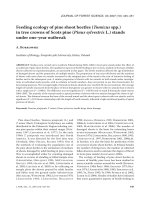Báo cáo lâm nghiệp: "Seasonal changes of plant hydraulics, water relations and growth of Aesculus hippocastanum seedlings infested by the leafminer Cameraria ohridella" ppt
Bạn đang xem bản rút gọn của tài liệu. Xem và tải ngay bản đầy đủ của tài liệu tại đây (902.53 KB, 6 trang )
99
Ann. For. Sci. 62 (2005) 99–104
© INRA, EDP Sciences, 2005
DOI: 10.1051/forest:2005001
Original article
Seasonal changes of plant hydraulics, water relations
and growth of Aesculus hippocastanum seedlings infested
by the leafminer Cameraria ohridella
Fabio RAIMONDO, Patrizia TRIFILÒ, Sebastiano SALLEO, Andrea NARDINI*
Dipartimento di Biologia, Università degli Studi di Trieste, via L. Giorgieri 10, 34127 Trieste, Italy
(Received 19 January 2004; accepted 8 April 2004)
Abstract – The leaf miner Cameraria ohridella causes premature defoliation in Aesculus hippocastanum. The impact of the parasite on seasonal
changes of water relations, hydraulics and growth of three-year-old A. hippocastanum seedlings was investigated. Leaf expansion was complete
before the adults of the moth developed, so that growth of infested seedlings was similar to that of controls. Leaf conductance to water vapour
of infested seedlings was reduced with respect to controls, both in mined and in still green portions of attacked leaves. In July and August, the
hydraulic resistance of infested seedlings was higher than that of controls, due to anticipated increase of hydraulic resistance at the leaf, petiole
and current-year stem level. This was interpreted as evidence of anticipated leaf senescence in infested plants, leading to early leaf abscission.
Nevertheless, our data suggest that, under our experimental conditions, C. ohridella is not a major mortality factor for A. hippocastanum seedlings.
Cameraria ohridella / Aesculus hippocastanum / seedling / hydraulic resistance / leaf
Résumé – Variations saisonnières des propriétés hydrauliques, des relations hydriques et de la croissance de jeunes plants d’Aesculus
hippocastanum infestés par la mineuse foliaire Cameraria ohridella. La mineuse foliaire Cameraria ohridella provoque des défoliations
prématurées chez le Marronnier (Aesculus hippocastanum). L’impact du parasite sur les variations saisonnières des relations hydriques, des
paramètres hydrauliques et de la croissance de plants d’A. hippocastanum âgés de 3 ans a été analysé. L’expansion foliaire étant terminée avant
que les adultes de l’insecte soient développés, la croissance des plants infestés fut similaire à celle des plants témoins. La conductance foliaire
à la vapeur d’eau des plants infestés fut réduite par rapport aux témoins, que ce soit dans les parties encore vertes des feuilles ou dans les parties
attaquées. En juillet et août, la résistance hydraulique des plants infestés fut plus élevée que celle des témoins, en raison d’une augmentation
anticipée de la résistance hydraulique des feuilles, des pétioles et des tiges de l’année. Ceci fut interprété comme une preuve d’une anticipation
de la sénescence foliaire pour les plants infestés, conduisant à une abscission prématurée des feuilles. Néanmoins, nos données suggèrent que,
dans nos conditions expérimentales, C. ohridella n’est pas un facteur majeur de mortalité pour les jeunes plant d’A. hippocastanum.
Cameraria ohridella / Aesculus hippocastanum / jeune plant / résistance hydraulique / feuille
1. INTRODUCTION
The leaf miner Cameraria ohridella Deschka et Dimic (Lepi-
doptera, Gracillariidae) is a moth whose larvae feed on the foli-
age of Aesculus hippocastanum L. (horse chestnut). In partic-
ular, larvae extensively tunnel the palisade parenchyma of the
leaves producing typical mines where upper and lower epider-
mis, spongy parenchyma and veins are left intact [13]. In recent
years, the moth has become a serious pest [5, 12] because it
causes severe and premature defoliation of horse chestnut
plants which are very common ornamentals of streets, parks
and gardens in European cities. Previous studies [13, 16, 17]
have shown that A. hippocastanum plants attacked by the par-
asite suffer a major damage in terms of reproductive potential
(they produce smaller seeds with limited viability). On the con-
trary, whole-plant photosynthetic productivity and hydraulics
of adult plants did not seem to be heavily affected [13, 16], as
recently confirmed on the basis of a mathematical model taking
into account seasonal changes of photosynthetic rate and dam-
age to foliage [9]. However, little is known of the potential
impact of C. ohridella on the hydraulics and productivity of
horse chestnut seedlings. Although natural propagation of A.
hippocastanum is of no interest for urban arboriculture, it has
to be taken into proper account that the species is an important
component of natural forests in the Balkans, where eventual
negative effects on plant reproduction and seedlings’ produc-
tivity and survival might have important consequences at the
ecosystem level [4, 6, 19].
Several studies show that seedlings are more vulnerable to
stress factors with respect to adult plants [1, 3, 7]. Therefore,
the impact of C. ohridella on seedlings of A. hippocastanum
can be hypothesized to be larger than that on adult individuals
of the same species. To test this hypothesis, seasonal changes of
plant hydraulics, water relations and growth rate were measured
* Corresponding author:
100 F. Raimondo et al.
of horse chestnut seedlings either infested by the leaf miner or
protected from the parasite attacks. The final aim of the present
study was to evaluate the risk of mortality in A. hippocastanum
seedlings attacked by C. ohridella.
2. MATERIALS AND METHODS
All experiments were performed between the year 2002 and 2003
on 300 three-year-old seedlings of A. hippocastanum. Before planting,
potted seedlings had a height of 0.60 ± 0.06 m and a trunk diameter
of 10.1 ± 2.5 mm. Seedlings were grown in a custom-made greenhouse
in the Botanical Garden of the University of Trieste at 120 m above
the sea level. The greenhouse was built with steel chassis and wood
supports and it was completely covered with a net (knitted fabric
0.5 mm) in order to prevent the free entrance of C. ohridella and other
parasites within the greenhouse. The same net was used to divide the
greenhouse into two different sections of similar dimensions. Soil
inside the greenhouse was ploughed and blended with peat in February
2002. Seedlings were randomly divided into two groups and planted
in early March 2002 with 0.3 m spacing between plants. The green-
house was equipped with an irrigation system and seedlings were irri-
gated twice per week starting from early April till September.
In one section of the greenhouse, the ground was covered with leaf
litter collected under adult horse chestnut trees that had been heavily
infested by the moth the previous year. This procedure had the aim to
favour leaf miner attack in one group of seedlings by adults emerging
from pupae overwintering in the dead foliage. This group of seedlings
was named “infested” (I) and compared to the other control (C) group
whose infestation by C. ohridella was prevented by the presence of
the net. Our experimental set-up allowed to grow C- and I-plants under
the same environmental conditions, the only difference between
groups being the presence or absence of the parasite.
2.1. Measuring seedling growth and leaf damage
In order to check whether C. ohridella infestation causes an alter-
ation of the seedlings’ growth potential, the following variables were
recorded every week on both C- and I-plants (12 seedlings per group):
(a) total stem length; (b) current-year stem length; (c) trunk diameter
20 mm above the ground; (d) total leaf surface area; (e) percentage of
leaf surface area covered by mines. Stem length was measured using
a rule and trunk diameter was measured using a digital caliper (Mitu-
toyo mod. 500). In order to measure total leaf surface area (A
L
) without
removing the foliage from seedlings, 25 leaves were collected and the
surface area of each leaflet was measured using a leaf area meter
(LI3000A, LiCor Inc.). The same leaflets were measured for their
maximum length and maximum width using a rule. These dimensions
were multiplied by each other and the result was plotted versus the cor-
responding leaflet surface area, thus obtaining a conversion factor
between the two parameters (Actual leaf surface area = 0.563 × leaf
length × leaf width, r = 0.997, P < 0.0001). Because the relationship
between the two turned out to be closely linear, hereafter only leaf
length and width of leaflets were measured and leaf surface area was
obtained by conversion. Starting from early May, when the first adults
of C. ohridella were observed in the I-section of the greenhouse,
20 leaves per week and per group were randomly collected from seedlings
of both groups and the mined leaf surface area was measured using a
leaf area meter (see above) and paper replicas of mines’ area. All mor-
phological measurements were undertaken between April and Sep-
tember 2002 and they were repeated in April, May and June 2003.
2.2. Measuring plant water relation parameters
In order to check the eventual alterations of seedlings’ water status
caused by C. ohridella attacks, the midday leaf conductance to water
vapour (g
L
) and water potential (Ψ
L
) were measured on both groups
of plants at two weeks intervals between April and September 2002.
Measurements were always performed one to two days after the last
irrigation. Measurements were performed at 1 h intervals between
11.00 h and 14.00 h. At least 8 leaves per group of plants and per day-
time were measured for g
L
using a steady-state porometer (LI1600,
LiCor Inc.) equipped with a narrow chamber (60 mm
2
surface area).
The narrow chamber allowed to measure leaf gas exchange of control
leaves as well as of mined and green areas even in heavily infested
leaves. Leaf water potential was measured of at least two leaves per
group and per daytime using a portable pressure chamber (3005 Plant
Water Status Console, Soilmoisture Equipment Corp., Goleta, CA,
USA) with wet paper inside the chamber to minimize water loss during
measurements.
In order to check eventual changes of solute accumulation and cell
walls properties as induced by the leaf miner infestation, leaf water
potential isotherms were measured of 4 leaves per group at two weeks
intervals. Briefly, leaves were collected the evening preceding the
experiments and their petiole was put in contact with distilled water.
Leaves were rehydrated in the dark, overnight, to full turgor. Then,
pressure-volume (PV) curves were obtained using the procedure
described by Salleo [14] and leaf osmotic potential at full turgor (π
0
)
and leaf water potential at the turgor loss point (Ψ
tlp
) were calculated.
2.3. Measuring plant hydraulics
Eventual changes in the plant hydraulic properties as induced by
C. ohridella attacks were estimated in terms of root (R
root
) and shoot
(R
shoot
) hydraulic resistance that were measured using a high pressure
flow meter (HPFM) [18], at two weeks intervals between April and
September 2002. Briefly, the HPFM consists of an apparatus that
allows the perfusion of distilled water (filtered at 0.1 µm) into the base
of a root system or a shoot while rapidly changing the applied pressure
(P) and simultaneously measuring the corresponding flow. The instru-
ment has been successfully used to measure the hydraulics of whole
root systems in situ [8, 10] as well as the partitioning of hydraulic
resistances within the shoot [11, 20]. Shoots were excised from the
roots (about 10 cm above the soil) under water by constructing a water-
tight container around the base of each plant. The HPFM was con-
nected to the root system and three to six transient flow measurements
were immediately performed. During each measurement, P was
increased at a rate of 5–8 kPa s
–1
while measuring the flow every 3 s.
The entire sequence of flow measurements took about 5 min. The flow
was then plotted versus the applied pressure and R was calculated from
the slope of the P to F linear regression. During R
root
measurements,
the shoots remained with the cut surface immersed in water while
enclosed in plastic bags to prevent evaporation. The base of the stem
was connected to the HPFM and the stem was perfused at a pressure
of 0.3 MPa for 30 min. Then, the pressure was decreased to 0.03 MPa
and maintained constant for 10 min. Three to five transient measure-
ments were performed and R was calculated as described above. Leaf
blades were then removed and R was measured again so that leaf
hydraulic resistance was calculated from:
R
leaf
= R
shoot
– R
residual
where R
residual
is the hydraulic resistance measured after removal of
leaf blades. The procedure was repeated with petioles and current-year
(cy) stems, thus obtaining R
petiole
and R
cy-stem
. All measurements
were corrected for temperature. At the end of each experiment, the leaf
surface area (A
L
) of the seedlings was measured using the leaf area
meter (see above) and R values were multiplied by A
L
in order to nor-
malize them for seedlings’ dimensions. Total plant hydraulic hydrau-
lic resistance (R
plant
) was finally calculated from:
R
plant
= R
root
+ R
shoot
.
Impact of Cameraria ohridella on horse chestnut 101
3. RESULTS
In the course of year 2002, control seedlings did not show
symptoms of C. ohridella attack thus confirming that the net
cover was effective in preventing casual infestation by the
moth. On the contrary, several adult moths emerging from the
leaf litter were observed in the “infested” section starting from
the end of April. Mines became apparent starting from May
(Fig. 1) but only in June did the leaf mined area increase to
above 10%. Later on, the percentage of damage increased dra-
matically up to about 55, 80 and 90% in July, August and Sep-
tember, respectively (Fig. 1).
C- and I-plants did not show any significant difference in
terms of total leaf surface area developed during 2002 and 2003
(Fig. 2). Complete leaf expansion occurred within the end of
April and early May i.e. before leaf mining produced signifi-
cant damage to the foliage. At the end of June 2002, total leaf
surface area of seedlings was about 0.2 m
2
. Also in 2003, meas-
urements revealed no significant difference between C- and
I-seedlings and total leaf surface area in June was about 0.5 m
2
,
with a significant increment with respect to year 2002. More-
over, no significant difference between C- and I-plants was
found in terms of current-year stem length (L
cy
) and trunk
diameter (Ø
T
), thus suggesting that infestation by the moth did
not induce any significant change in the growth potential and
pattern of A. hippocastanum seedlings (Tab. I).
3.1. Leaf gas exchange and water relations parameters
In late April 2002, when leaf expansion was almost complete
and leaves had not suffered any damage yet, maximum g
L
recorded was about 160 mmol m
–2
s
–1
with no significant dif-
ference between seedlings growing in the C- or I-section of the
greenhouse (Fig. 3). During the course of the season, g
L
remained more or less constant in C-plants, while it showed to
decrease in I-ones. This g
L
reduction was only partial in green
parts of infested leaves with respect to controls but it was very
marked at the mine level. As an example, in July 2002, g
L
was
about 160, 130 and 60 mmol m
–2
s
–1
in control leaves and in
green and mined portions of infested leaves, respectively
(Fig. 3). In September, g
L
decreased to about 60 mmol m
–2
s
–1
both in control leaves and in green portions of infested ones.
Although statistically significant differences between C-
and I-seedlings were apparent in terms of leaf gas exchange
rates, this did not translate into significant differences in terms
of Ψ
L
(Fig. 4). Leaf water potential showed quite high values
Figure 1. Seasonal changes of percentage of leaf mined surface area
as measured in infested seedlings during year 2002. Means are repor-
ted ± SD (n = 20).
Table I. Total leaf surface area (A
L
), length of current-year stem
(L
cy
) and trunk diameter (∅
T
) of control and infested seedlings as
measured after complete leaf expansion (A
L
) or after complete
foliage loss (L
cy
and ∅
T
). Means are reported ± SD (n = 12). n.s. =
not significant.
Control Infested
A
L
, m
2
0.43 ± 0.19 0.53 ± 0.13 n.s.
L
CY
, m 0.27 ± 0.12 0.25 ± 0.10 n.s.
∅
T
, mm 12.2 ± 2.10 13.9 ± 1.87 n.s.
Figure 2. Seasonal changes of seedling leaf surface area as measured
in control (black columns) and infested (dashed columns) seedlings
during the first (2002) and second (2003) year of attacks by C. ohri-
della. Means are reported ± SD (n = 20).
102 F. Raimondo et al.
until June (Ψ
L
≥ –0.6 MPa) and decreased markedly to about
–1.50 MPa only in July and similar values were maintained
until September. This Ψ
L
decrease was the likely result of
increased air temperatures which, in turn, induced higher tran-
spiration rates and water loss. In accordance with the lack of
statistically significant differences between C- and I-seedlings
in terms of the Ψ
L
seasonal time course, the infestation by
C. ohridella did not induce modifications of solute accumula-
tion or of cell wall properties in attacked plants, as indicated
by the lack of significant difference between infested plants and
controls in terms of π
0
and Ψ
tlp
(Fig. 5). A slightly significant
difference between C- and I-plants in this respect was recorded
only in August (Fig. 5).
3.2. Seedlings’ hydraulics
Whole-plant hydraulic resistance turned out to be not statis-
tically different between controls and infested seedlings up to
June (Fig. 6). On the contrary, in July and August plant hydraulic
resistance (R
plant
) was significantly higher in infested seedlings.
This increase was not due to changes in the hydraulic properties
of the roots, as indicated by the relative constancy of root
hydraulic resistance (R
root
). A detailed analysis of seasonal
changes of the hydraulic resistance of different shoot compart-
ments revealed that the reduction in the hydraulic efficiency of
infested seedlings was mainly due to a loss of function of cur-
rent-year stems, although with some contribution of leaves and
petioles in this respect (Fig. 6). In particular, the hydraulic
resistance of cy-stem (R
cy-stem
) was, in July, as high as 1.8 ×
10
3
MPa s m
2
kg
–1
as compared to about 0.8 × 10
3
MPa s m
2
kg
–1
recorded in controls. It is of interest to note that, in August, the
R
cy-stem
of controls increased to values similar to those recorded
in infested plants in July. Similar changes were observed for
leaf (R
leaf
) and petiole (R
petiole
) hydraulic resistances.
4. DISCUSSION
During 2002, the first adults of the moth were observed in
the greenhouse starting from late April. Until June, however,
the percentage of mined leaf surface area remained relatively
low (less than 20%) and only starting from July it increased to
high levels (over 50%, Fig. 1). This attack time course is in
accordance with that observed for adult horse chestnut individ-
uals over previous years [9] and has important consequences
for plant fitness. In fact, most temperate woody plants complete
their leaf expansion and growth by late spring, already, so that
Figure 3. Seasonal changes of leaf conductance to water vapour (g
L
)
as measured in control leaves (black columns) and in green (dashed
columns) and mined (white columns) areas of infested leaves. Means
are reported ± SD (n = 8). Different letters indicate significant diffe-
rences (P < 0.05) for Tukey pairwaise comparisons.
Figure 4. Seasonal changes of leaf water potential (Ψ
L
) as measured
for leaves of control (black columns) and infested (dashed columns)
seedlings. Mean are reported ± SD (n =8).
Figure 5. Seasonal changes of leaf water potential at the turgor loss
point (Ψ
tlp
) and leaf osmotic potential at full turgor (π
0
) as estimated
from pressure-volume curves for leaves of control (black columns)
and infested (dashed columns) seedlings. Means are reported ± SD
(n = 4). Statistically significant differences are indicated (* P < 0.05).
Impact of Cameraria ohridella on horse chestnut 103
any reduction of photosynthetically active leaf surface area
after this time can be expected to have limited impact on annual
growth. In particular, our seedlings completed their leaf expan-
sion about 30 days after sprouting and in any case before the
first mines became apparent on leaf surface (see Fig. 2). Data
relative to seedlings’ growth did not reveal any statistically sig-
nificant difference between control and infested plants in terms
of total leaf surface area, stem length or trunk diameter (Fig. 2
and Tab. I). We do not know what the impact could be of severe
defoliations repeated over several years on seedlings’ growth.
However, we note that even after two years of severe moth
attack, infested seedlings did not show any growth reduction
with respect to controls (Fig. 2). Moreover, all seedlings sur-
vived after two years of infestation, so that C. ohridella cannot
be regarded as a major mortality factor for horse chestnut seed-
lings, at least under our experimental conditions. It has to be
noted, however, that three-year old seedlings were used in the
present study, so that no information can be inferred from our
data about the risk of mortality associated with the infestation
of seedlings during the very early growth stages. In fact, mor-
tality associated with insect herbivory is known to be strongly
influenced by seedlings’ age [6].
Leaf gas exchange showed to be affected by the leaf miner
attack (Fig. 3). Leaf conductance to water vapour was strongly
reduced at the mine level with respect to control leaves, and
even green portions of infested leaves showed decreased g
L
val-
ues. This effect was not observed in the case of adult plants [13]
where g
L
of green portions of infested leaves was unchanged
with respect to controls. We do not know the physiological
basis for the presence or the absence of borderline effects of
mines on the photosynthetic apparatus of still green parts of the
leaf blade. We note, however, that due to this effect, the impact
Figure 6. Seasonal changes of leaf specific hydraulic resistance at the whole plant level and for different plant organs, as measured in control
(black columns) and infested (dashed columns) seedlings. Means are reported ± SD (n = 5). Statistically significant differences are indicated
(* P < 0.05; ** P < 0.01).
104 F. Raimondo et al.
of the leaf miner on whole plant photosynthetic productivity
might be larger in seedlings than in adult trees. The implications
of this finding for long-term seedlings’ competitivity and sur-
vival remain unknown and deserve further studies. In accord-
ance with observations made on adult individuals [13], leaf
water status was not affected by the leaf miner attack (Fig. 4),
so that no significant osmotic adjustment could be observed in
leaves from infested seedlings with respect to controls (Fig. 5).
Only in August both Ψ
tlp
and π
0
were significantly lower in
I-plants with respect to controls (Fig. 5) but the difference was
rather small (between 10 and 15%) and of probably limited
physiological significance.
The most interesting effect of the leaf miner on seedlings’
physiology was observed at the level of plant hydraulics
(Fig. 6). In fact, infested plants showed increased plant hydrau-
lic resistance starting from July. This was associated with
increased hydraulic resistance at the leaf, petiole and especially
cy-stem level, while root hydraulics was apparently not
affected by the parasite. In a previous study by some of us [15],
late summer increase of petiole and stem hydraulic resistance
was showed to represent a precocious signal leading to leaf
senescence and shedding. Similar observations have been
reported for leaf hydraulics by Brodribb & Holbrook [2]. In our
opinion, the observed increase of R
leaf
, R
petiole
and R
cy-stem
in
horse chestnut seedlings has to be interpreted as evidence of
anticipated leaf senescence in infested seedlings with respect
to controls, leading to precocious leaf shedding and plant defo-
liation. In fact, similar increases in R were observed also in con-
trol seedlings where, however, a similar increase in R was
delayed by about one month. As an example, R
cy-stem
of
infested plants was about 1.8 × 10
3
MPa s m
2
kg
–1
in July, ver-
sus only 0.7 × 10
3
MPa s m
2
kg
–1
recorded in controls. In
August, however, also R
cy-stem
of controls sharply increased,
reaching values similar to those recorded in infested seedlings
(about 2.0 × 10
3
MPa s m
2
kg
–1
). In this view, the premature
defoliation of horse chestnut plants attacked by C. ohridella
should be not regarded as a mere consequence of leaf mining
and desiccation, but as a physiological process regulated by the
plant in order to eliminate foliage whose photosynthetical
activity has been strongly reduced.
In conclusion, our data suggest that repeated attacks of the
leaf miner C. ohridella do not lead to growth reduction of A.
hippocastanum seedlings, although leaf gas exchange and plant
hydraulics were partly affected by the parasite. In particular, the
leaf miner attacks induced anticipated leaf senescence via
increased hydraulic impairment at the leaf, petiole and espe-
cially cy-stem level. The possible impact of longer term attacks
on seedlings’ growth, competitivity and survival, as well as the
physiological response of seedlings younger than three years
of age remains unknown and awaits further investigations pos-
sibly addressed at evaluating growth and mortality of horse
chestnut seedlings in natural stands.
Acknowledgments: The present study was funded by EU in the
framework of the project entitled “Sustainable control of the horse
chestnut leafminer, Cameraria ohridella (Lepidoptera, Gracillarii-
dae), a new invasive pest of Aesculus hippocastanum in Europe”
(CONTROCAM, Contract No. QLK5-2000-01684).
REFERENCES
[1] Bragg W.K., Knapp A.K., Briggs J.M., Comparative water rela-
tions of seedling and adult Quercus species during gallery forest
expansion in tallgrass prairie, For. Ecol. Manage. 56 (1993) 29–41.
[2] Brodribb T.J., Holbrook N.M., Changes in leaf hydraulic conduc-
tance during leaf shedding in seasonally dry tropical forest, New
Phytol. 158 (2003) 295–303.
[3] Cavender-Bares J., Bazzaz F., Changes in drought response strate-
gies with ontogeny in Quercus rubra: implications for scaling from
seedlings to mature trees, Oecologia 124 (2000) 8–18.
[4] Figueroa J.A., Castro S.A., Effect of herbivores and pathogens on
the survival and growth of seedlings in a fragment of the Chiloe
rainforest, Chile, Rev. Chil. Hist. Nat. 73 (2000) 163–173.
[5] Gilbert M., Svatos A., Lehmann M., Bacher S., Spatial patterns and
infestation processes in the horse chestnut leafminer Cameraria
ohridella: a tale of two cities, Entomol. Exp. Appl. 107 (2003) 25–37.
[6] Jackson R.V., Bach C.E., Effects of herbivory on growth and survi-
val of seedlings of a rainforest tree, Alphitonia whitei (Rhamna-
ceae), Aust. J. Ecol. 24 (1999) 278–286.
[7] McNamara S., Pellett H., Cold hardiness of Phellodendron sacha-
linense Friedr. Schmidt seedlings increases with age, HortScience
35 (2000) 304–305.
[8] Nardini A., Lo Gullo M.A., Salleo S., Competitive strategies for
water availability in two Mediterranean Quercus species, Plant Cell
Environ. 22 (1999) 109–116.
[9] Nardini A., Raimondo F., Scimone M., Salleo S., Impact of the leaf
miner Cameraria ohridella on whole-plant photosynthetic produc-
tivity of Aesculus hippocastanum: insights from a model, Trees 18
(2004) 714–721.
[10] Nardini A., Salleo S., Lo Gullo M.A., Pitt F., Different responses to
drought and freeze stress of Quercus ilex L. growing along a latitu-
dinal gradient, Plant Ecol. 148 (2000) 141–149.
[11] Nardini A., Tyree M.T., Root and shoot hydraulic conductance of
seven Quercus species, Ann. For. Sci. 56 (1999) 371–377.
[12] Pavan F., Barro P., Bernardinelli I., Gambon N., Zandigiacomo P.,
Cultural control of Cameraria ohridella on horsechestnut in urban
areas by removing fallen leaves in autumn, J. Arboric. 29 (2003)
253–258.
[13] Raimondo F., Ghirardelli L.A., Nardini A., Salleo S., Impact of the
leaf miner Cameraria ohridella on photosynthesis, water relations
and hydraulics of Aesculus hippocastanum leaves, Trees 17 (2003)
376–382.
[14] Salleo S., Water relations of two Sicilian species of Senecio
(Groundsel) measured by the pressure bomb technique, New Phy-
tol. 95 (1983) 179–188.
[15] Salleo S., Nardini A., Lo Gullo M.A., Ghirardelli L.A., Changes in
stem and leaf hydraulics preceding leaf shedding in Castanea
sativa L., Biol. Plant. 45 (2002) 227–234.
[16] Salleo S., Nardini A., Raimondo F., Lo Gullo M.A., Pace F.,
Giacomich P., Effects of defoliation by the leaf miner Cameraria
ohridella on wood production and efficiency in Aesculus hippocas-
tanum growing in north-eastern Italy, Trees 17 (2003) 367–375.
[17] Thalmann C., Freise J., Heitland W., Bacher S., Effects of defolia-
tion by horse chestnut leafminer (Cameraria ohridella) on repro-
duction in Aesculus hippocastanum, Trees 17 (2003) 383–388.
[18] Tyree M.T., Patiño S., Bennink J., Alexander J., Dynamic measu-
rements of root hydraulic conductance using a high-pressure flow-
meter in the laboratory and field, J. Exp. Bot. 46 (1995) 83–94.
[19] Weltzin J.E., Archer S.R., Heitschmidt R.K., Defoliation and
woody plant (Prosopis glandulosa) seedling regeneration: potential
vs. realized herbivory tolerance, Plant Ecol. 138 (1998) 127–135.
[20] Yang S., Tyree M.T., Hydraulic architecture of Acer saccharum
and A. rubrum: comparison of branches to whole trees and the con-
tribution of leaves to hydraulic resistance, J. Exp. Bot. 45 (1994)
179–186.
